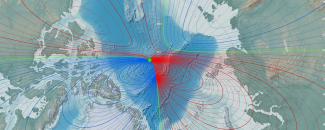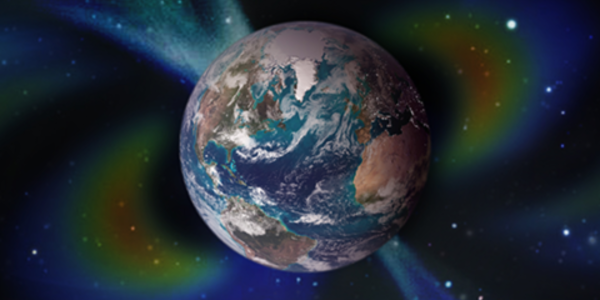
As Earth's magnetic field varies over time, the positions of the North and South Magnetic Poles gradually change. Magnetic declination—the angle between magnetic North and true North—at a given location also changes over time. Our Historical Magnetic Declination Map Viewer displays locations of the geomagnetic poles and historical declination lines calculated for the years 1590–2020.
Earth's Magnetic History
Sir James Clark Ross first discovered the North Magnetic Pole in northern Canada in 1831. Since 1831, the pole has been moving across the Canadian Arctic toward Russia. NCEI scientists with the Cooperative Institute for Research in Environmental Sciences (CIRES) at the University of Colorado Boulder calculated the movement of both the North and South Magnetic Poles from 1590 to 2025 using two models: gufm1 and IGRF. Gufm1 incorporates thousands of magnetic observations taken by mariners engaged in merchant and naval shipping. The IGRF is the product of a collaborative effort between magnetic field modelers and the institutes involved in collecting and disseminating magnetic field data from satellites and from observatories and surveys around the world. A survey in 2007 by a Canadian–French international collaboration determined that the North Magnetic Pole was moving approximately north-northwest at 55 km per year. According to the latest IGRF, the Pole is currently moving in the same direction but at a slightly reduced speed of about 45 km per year.
NCEI and CIRES scientists created an animation showing changes in declination location and the “wandering” of the North Magnetic Pole over the last 50 years. Watch how the isogonic lines converge at the Pole. View historic data back to 1590 with our Map Viewer.
Plates and Polarity: Synchronicity
Earth’s magnetic field has been slowly changing throughout its existence. When the tectonic plates form along the oceanic ridges, the magnetic field that exists is “frozen” into the rock as they cool below about 700°C. The slowly moving plates act as a kind of tape recorder leaving information about the strength and direction of past magnetic fields. By sampling these rocks and using radiometric dating techniques, it has been possible to reconstruct the history of Earth's magnetic field for roughly the last 160 million years. If one “plays the tape backwards,” the record shows Earth’s magnetic field strengthening, weakening, and often changing polarity. Magnetic North and South Poles have even reversed or “flipped,” which is known as geomagnetic pole reversal.
Geomagnetic pole reversals have happened throughout Earth's history. The last one occurred 780,000 years ago. Though they sound scary, pole flips can take a long time to occur and pose no immediate threat. Scientists have determined that, in the short-term, there is no real change to Earth’s environment and no threat to life due to a pole flip.



